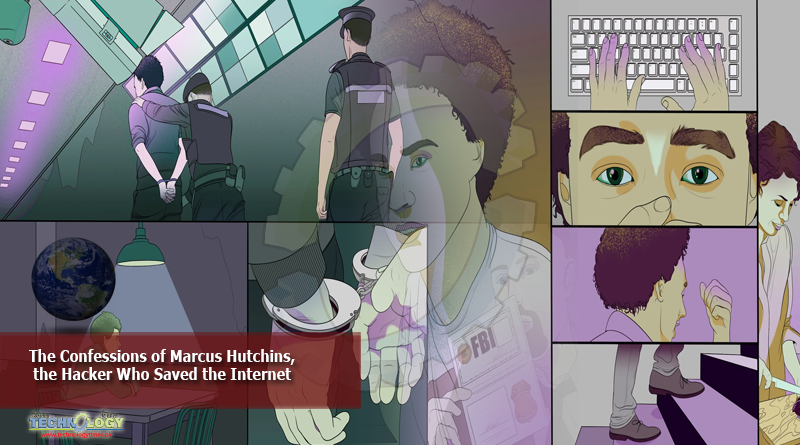At 22, he single-handedly put a stop to the worst cyberattack the world had ever seen. Then he was arrested by the FBI. This is his untold story.

AT AROUND 7 am on a quiet Wednesday in August 2017, Marcus Hutchins walked out the front door of the Airbnb mansion in Las Vegas where he had been partying for the past week and a half. A gangly, 6’4″, 23-year-old hacker with an explosion of blond-brown curls, Hutchins had emerged to retrieve his order of a Big Mac and fries from an Uber Eats deliveryman. But as he stood barefoot on the mansion’s driveway wearing only a T-shirt and jeans, Hutchins noticed a black SUV parked on the street—one that looked very much like an FBI stakeout.
He stared at the vehicle blankly, his mind still hazed from sleep deprivation and stoned from the legalized Nevada weed he’d been smoking all night. For a fleeting moment, he wondered: Is this finally it?
But as soon as the thought surfaced, he dismissed it. The FBI would never be so obvious, he told himself. His feet had begun to scald on the griddle of the driveway. So he grabbed the McDonald’s bag and headed back inside, through the mansion’s courtyard, and into the pool house he’d been using as a bedroom. With the specter of the SUV fully exorcised from his mind, he rolled another spliff with the last of his weed, smoked it as he ate his burger, and then packed his bags for the airport, where he was scheduled for a first-class flight home to the UK.
Hutchins was coming off of an epic, exhausting week at Defcon, one of the world’s largest hacker conferences, where he had been celebrated as a hero. Less than three months earlier, Hutchins had saved the internet from what was, at the time, the worst cyberattack in history: a piece of malware called WannaCry. Just as that self-propagating software had begun exploding across the planet, destroying data on hundreds of thousands of computers, it was Hutchins who had found and triggered the secret kill switch contained in its code, neutering WannaCry’s global threat immediately.
This legendary feat of whitehat hacking had essentially earned Hutchins free drinks for life among the Defcon crowd. He and his entourage had been invited to every VIP hacker party on the strip, taken out to dinner by journalists, and accosted by fans seeking selfies. The story, after all, was irresistible: Hutchins was the shy geek who had single-handedly slain a monster threatening the entire digital world, all while sitting in front of a keyboard in a bedroom in his parents’ house in remote western England.Support our journalism.The news you need to know on Covid-19 and beyond.
Still reeling from the whirlwind of adulation, Hutchins was in no state to dwell on concerns about the FBI, even after he emerged from the mansion a few hours later and once again saw the same black SUV parked across the street. He hopped into an Uber to the airport, his mind still floating through a cannabis-induced cloud. Court documents would later reveal that the SUV followed him along the way—that law enforcement had, in fact, been tracking his location periodically throughout his time in Vegas.
When Hutchins arrived at the airport and made his way through the security checkpoint, he was surprised when TSA agents told him not to bother taking any of his three laptops out of his backpack before putting it through the scanner. Instead, as they waved him through, he remembers thinking that they seemed to be making a special effort not to delay him.
He wandered leisurely to an airport lounge, grabbed a Coke, and settled into an armchair. He was still hours early for his flight back to the UK, so he killed time posting from his phone to Twitter, writing how excited he was to get back to his job analyzing malware when he got home. “Haven’t touched a debugger in over a month now,” he tweeted. He humblebragged about some very expensive shoes his boss had bought him in Vegas and retweeted a compliment from a fan of his reverse-engineering work.Most Popular
- BACKCHANNELWho Invented the Wheel? And How Did They Do It?CODY CASSIDY
- SCIENCEWhy Meatpacking Plants Have Become Covid-19 Hot SpotsMEGAN MOLTENI
- PHOTOThe Eerie Stillness of Empty SchoolyardsLAURA MALLONEE
- IDEASCovid-19’s Scary Blood Clots Aren’t That SurprisingROXANNE KHAMSI
Hutchins was composing another tweet when he noticed that three men had walked up to him, a burly redhead with a goatee flanked by two others in Customs and Border Protection uniforms. “Are you Marcus Hutchins?” asked the red-haired man. When Hutchins confirmed that he was, the man asked in a neutral tone for Hutchins to come with them, and led him through a door into a private stairwell.
Then they put him in handcuffs.
In a state of shock, feeling as if he were watching himself from a distance, Hutchins asked what was going on. “We’ll get to that,” the man said.
Hutchins remembers mentally racing through every possible illegal thing he’d done that might have interested Customs. Surely, he thought, it couldn’t be the thing, that years-old, unmentionable crime. Was it that he might have left marijuana in his bag? Were these bored agents overreacting to petty drug possession?
The agents walked him through a security area full of monitors and then sat him down in an interrogation room, where they left him alone. When the red-headed man returned, he was accompanied by a small blonde woman. The two agents flashed their badges: They were with the FBI.
Courtesy: wired
